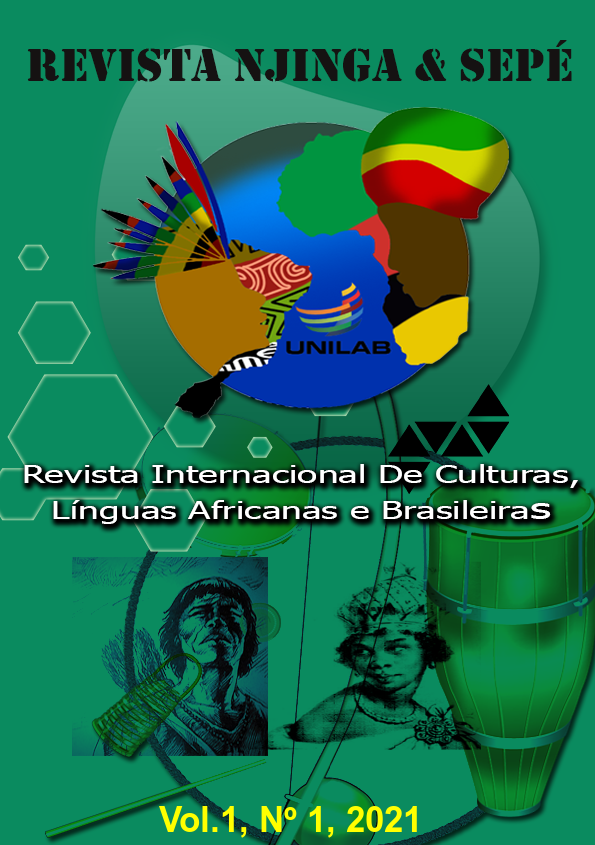Pensar na morfossintaxe de substantivos de prefixos zero (Ø) e do prefixo /KU-/ da classe 15 em cokwe (K10)
Palabras clave:
Morfossintaxe, Substantivo, Prefixo zero, Cokwe, AngolaResumen
Pensar na morfossintaxe de substantivos a prefixo zero e do prefixo 15 em Cokwe é um tema intencional e de grandes propósitos. O Cokwe, língua de Angola, é falado em todo o Leste, nas actuais províncias administrativas da Lunda Norte, Lunda Sul, Moxico e Kwando Kubango. A existência de materiais didácticos sobre o assunto em epígrafe é quase nula. Pensar na existência de documentos escritos sobre o referido assunto é uma tarefa de todos aqueles que investem no domínio da descrição das línguas Bantu de Angola e não só. Com a ajuda da descrição linguística, os substantivos a prefixo zero, a nível morfológico, estão concentrados, em Cokwe, em grande medida, nas classes do singular nomeadamente 1, 3, 5, 9 e 10, este último do plural. Portanto, a dificuldade é de saber quando é que o substantivo está no singular ou no plural fora da construção sintáctica. Desta feita, é possível descobrir e minimizar as dificuldades apoiando-se nas técnicas de comutação e substituição bem como da flexão baseada no esquema de género ou emparelhamento dos prefixos da língua. De igual modo, os nomes de prefixo 15 têm acordos sintácticos deslocados ou irregulares. Aqueles substantivos que designam os concretos e denominativos realizam os acordos na classe do singular regular de onde se providencia o plural, isto é, a classe 6. Portanto, em Cokwe, o prefixo 15 /ku-/ não é operante no eixo sintagmático.
Uhihiso (Cokwe): Kunyonga ha mofolosindase ya majina keshi kateteko (pelefisu Ø) nyi majina akateteko wa ngango 15 mulimi lya Cokwe, ce cishina ca yihanjeka hanji yisoneko yino. Cokwe lili limi ahanjika mu Ngola cihanda ceswe ca civumbuko cacifuci mumathungu aLunda wa kusango, waWutho, Mushiko ndusu kuKwandu nyi Kuvangu. Kuhona cayisoneko yinathwala hamalongeso wano cili cikuma catushinjika kusoneka. Mba majina ahona tuteteko (pelefisu) kanasolokela mungango ja 1, 3, 5, 9 nyi 10. Alyoze ngango yasulako yamajina awunji (phululale) mba ngango jitangu jeswe ja kuwuwika (singulale). Hakuwana kateteko unahono mujina, catamba kwalumuna jina kuwunji (phululale)cipwe kusa jina mumulongo wawuhanjikilo (falaze). Wano malinjekela àli kàli awumwenemwene kusolola kateteko unahono. Kuthwala hakateteko wamajina angango ya 15 kakulumbanganyisa mulongo wakuhanjika (falaze) mumu kateteko kaco keshi kusongwela mulongo ndo kucinyina mukateteko wa ngango 5 mba mulongo ulongoloke nyi ulumbunuke. Nawa majina angango yino kakwalumuna unji mungango ya 6. Ayino ye yitanga ya kateteko wangango 15 nyi yitalingiso yenyi.
Descargas
Citas
AUSTIN, Peter. K. 1.000 lenguas. Lenguas vivas y extintas de todo el mundo. Editorial Oceano Ambar. Barcelona. 2009.
BASTIN, Y. “Les mots pour tout et seul dans les langues bantoues” in Africana linguistic VII. 1977. P.1-56.
BENVENISTE, Emile. Problèmes de linguistique générale. Volume 2. Paris. Gallimard. 1974.
CREISSELS, Dénis. Aperçu sur les structures phonologiques des langues négro-africaines. Université de Stendhal. ELLUG. 1994.
CREISSELS, Denis. Description de langues négro-africaines et théorie syntaxique. 2ª Édition. Grenoble. ELLUG. Université Stendhal. 1991.
DE ANDRADE, Ernesto. Breve Introdução à linguística africana. Fonética e Morfologia. Edições Santos. FLUL/CLUL. 2008.
GUTHRIE, M. The classification of Bantu Languages. London. International African Institute. (IAI). 1948.
HEINE, B. A typology of African languages based on the order of meaningful elements. Berlin: Dietrich Reimer. 1976.
HEINE, B., NURSE, D. African Languages. Cambridge. Cambridge University Press. 2000.
MINGAS, A. Étude grammaticale de l’Iwoyo-Angola. Sciences du langages, Université Paris V, René Descartes, Paris, 1995.
MINGAS, A. Interferências do Kimbundu no Português falado em Lwanda. Chá de Caxinde, Luanda, 2000.
MUKASH, Kalel. Questions Spéciales de Linguistique Générale. Syntaxe des langues bantu. CRP. Kinshasa. 2004.
NDONGA, Mfuwa. Systématique Grammaticale du Kisikongo. Thèse de Doctorat. Université Paris V. Sciences du Langage, 1995.
NTONDO, Zavoni. Morfologia e Sintaxe do Ngangela. Luanda. 1ª Edição. Nzila editorial. 2006.
OKOUDOWA, Bruno. Morfologia verbal do Lembaama. Tese de Doutoramento. São Paulo. 2010.
PEDRO, J. Domingos. Étude Grammaticale du Kimbundu. Sciences du langage, Université Paris V. 1993.
SEVERO, Cristine; SASSUCO, Daniel e BERNARDO, Ezequiel. Português e línguas bantu na educação angolana: da diversidade como “problema”. Revista Línguas e Instrumentos Linguísticos. Número 43. 2019. P. 290-307.
TUSON, Jesús. Introducció a la lingüística. Educaula. Editorial 62. Barcelona. 2009
ZEMMOUR, David. Initiation à la linguistique. Thèmes & Études. Ellipses. 2008
Descargas
Publicado
Cómo citar
Número
Sección
Licencia
Derechos de autor 2021 NJINGA&SEPÉ: Revista Internacional de Culturas, Línguas Africanas e Brasileiras

Esta obra está bajo una licencia internacional Creative Commons Atribución-NoComercial-SinDerivadas 4.0.
Los autores que publican en esta revista aceptan los siguientes términos:
Los autores mantienen los derechos de autor y otorgan a la revista el derecho a la primera publicación, siendo el trabajo simultáneamente licenciado bajo la Licencia de Atribución Creative Commons, que permite compartir el trabajo con reconocimiento de la autoría del trabajo y la publicación inicial en esta revista.
Se autoriza a los autores a asumir contratos adicionales por separado, para la distribución no exclusiva de la versión del trabajo publicado en esta revista (p. Ej., Publicación en repositorio institucional o como capítulo de libro), con reconocimiento de autoría y publicación inicial en esta revista.
Se permite y se anima a los autores a publicar y distribuir su trabajo en línea (por ejemplo, en repositorios institucionales o en su página personal) en cualquier momento antes o durante el proceso editorial, ya que esto puede generar cambios productivos, así como aumentar el impacto y cita del trabajo publicado (Ver El efecto del acceso abierto).




